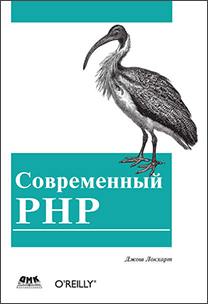The book "Modern PHP"
 Although modern developers are increasingly focused on network sources of information, it seems to me that books devoted to programming still have their niche. Articles represent the solution of specific problems, the description of specific points. Books are a more general view of technology, a review of best practices, and a full coverage of the technological process. In general, books are a collection of articles devoted to one big topic and complementing one another.
Although modern developers are increasingly focused on network sources of information, it seems to me that books devoted to programming still have their niche. Articles represent the solution of specific problems, the description of specific points. Books are a more general view of technology, a review of best practices, and a full coverage of the technological process. In general, books are a collection of articles devoted to one big topic and complementing one another. My acquaintance with the book "Modern PHP" took place in the momentous moment for me to return to programming in PHP after almost a decade of work outside of active coding. I needed a brief overview of what has happened in PHP lately and I received it with interest.
Despite the fact that the book was released “in the West” as much as in 2015, and in Russia in 2016 and, it would seem, what kind of “modern PHP” can we talk about? But I can assure you that the book has been compiled amazingly well, and in principle it cannot become obsolete.
Let's take a look inside and see why this is so.
The book consists of 3 parts: "Features of the language", "Advanced technologies", "Deployment, testing and configuration." And a couple of applications: “Installing PHP” and “Local Development Environment”.
The first part of “Language Features” tells how and what PHP came to from version 5.0. This is an excellent short material, which describes not only the added functions, but also describes the best practices for their use. We consider namespaces, interfaces, traits, generators, closures, ZendOPcache, embedded HTTP-server. To me, as having missed a large half of this mess, the information turned out to be extremely interesting.
The second part of "Advanced Technology" is devoted to the standards PSR 1-4, and all the same best practices. The author talks about the new world of PHP, in which frameworks retreat before components. I liked this idea, I always considered frameworks cumbersome and inwardly shudder at the need to study them, although, of course, much depends on specific tasks.
The third part of the book is formally devoted to the deployment, profiling and testing. However, it actually talks about the PHP community and ecosystem. It contains a lot of interesting links and gives the author’s method of preparing a PHP specialist’s workplace. The approach itself is interesting, but I was not close.
Verdict
As can be seen, the structure of the book is built not so much on specific points of the language as on a more general overview of the technology. The author showed what PHP is good for and in which direction the reader “digs further”. This is its value - a complete look.
Is this book worth buying? This is a question that you have to answer yourself on the basis of your tasks. The book is sensible and in my case it has become an excellent addition to the already battered book “PHP 5” by Z. Suraski and L. Atkinson. For me - these books are worth each other.
PS:
Since we have a paper book review, we should say a few words about its appearance and parameters. The cover design is traditional for translations of O'REILLY, printed on good white paper, 300 pages, paperback, A5 format. The book is pleasant to take in hand, convenient to take with you. The interior design also does not cause any complaints.
